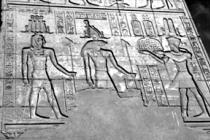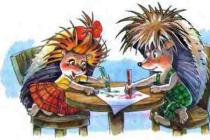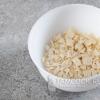Slide 2
“They say that there are friendly and hostile colors, and this is true if we take into account that some of them are so difficult to combine and are so annoying to the eye with their proximity to others that even air and light - these universal creators of harmonies - can hardly reconcile us with their immediate proximity” D. Diderot
Slide 3
In 1676, Newton conducted an experiment on splitting a light beam using a prism: having darkened the window and leaving a small hole in it, Newton placed a glass prism in front of the sunbeam penetrating through this hole. A white beam of light, passing through a prism, turned into a successive series of colors, which were displayed on a screen located behind the prism. As a result, he received 7 clearly distinguishable colors of the spectrum. 3
Slide 4
Color is a physical phenomenon that is formed by the refraction of light. Colors are divided into: Chromatic - all the colors of the rainbow Achromatic - white and black 4
Slide 5
Slide 6
Basic color characteristics
hue (color hue) lightness saturation 6
Slide 7
Slide 8
The term “harmony” comes from the Greek word “harmonia” - which means consonance, agreement. Color harmony in painting is the consistency of colors among themselves as a result of the found proportionality of colors, their balance and consonance, based on finding the unique shade of each color. Color harmony is the most important means artistic expression in painting along with composition, design, perspective, chiaroscuro and texture 8
Slide 9
Types of Color Harmonies
Related Monochrome Triple Contrast 9
Slide 10
A. Ya. Golovin “Kupavki” 10
Slide 11
A harmonious combination, interrelation, tonal combination of different colors in a picture is called color. Color reveals to us the colorful richness of the world. It helps the artist convey the mood of the painting: the color can be warm and cold, light and dark, calm, joyful, anxious, sad, etc.
Slide 12
Coloring is like the “color clothing” of a painting. It is not each of the color spots that is important, but their relationship in color and size. Color in painting is the nature of the relationship between all the color elements of a work, its color structure as one of the means of a truthful and expressive depiction of reality. Color reveals the colorful richness of the world. 12
Slide 13
Dutch still life 13
Slide 14
“Still life with attributes of art” “Still life with attributes of science” 14
Slide 15
“Sunflowers” “Irises” 15
Slide 16
“Fruit and bronze” “Red fish” 16
Slide 17
“Roses” “Roses, Fruits, Wine” 17
Slide 18
“Dry paints” “Agave” 18
Slide 19
"Still life. Fish" "Moscow food. Breads" 19
Slide 20
“Linen” 20 “Still life with apples”
Slide 21
Conclusion: A harmonious combination, interrelation, tonal combination of different colors in a picture is called color. Color helps the artist convey the mood of the painting; it can be warm and cold, light and dark, calm, joyful, anxious, sad, etc. Color influences the viewer’s feelings, creates the mood in the painting and serves as an important means of figurative and psychological characterization. Thus, color is the most valuable quality of painting; in other words, color determines painting: there is color, which means there is painting. 21
ART
2 CLASS
Art teacher
Municipal educational institution "Gymnasium "Logos"
Goryacheva Elena Nikolaevna
year 2013
Lesson topic: 2nd grade. “Color is the soul of painting”
Type of lesson:
1. Conversation about art.
2. Thematic drawing in 2nd grade.
Lesson topic:
Landscape image.
Target:
Tasks:
Educational:
consolidation of acquired knowledge about the color wheel, warm and cold colors, and the technique of mixing primary colors;
continue mastering the technique of painting with gouache paints.
Educational:
conveying mood through color, creating a certain flavor;
be able to carry out a verbal and pictorial description of a painting using the concepts of “color”, “Warm and cold shades”;
develop TV orcish imagination and attention.
- to cultivate the ability to emotionally and value-wise perceive works of fine art, to express one’s attitude to the surrounding world in creative works
cultivate artistic taste inbased on the study of artists' works;
develop the ability to work and create;
nurturing love for nature;
P introducing students to aesthetic culture.
Teacher equipment:
Reproductions of paintings with landscapes and still lifes:
Presentation “Color – the soul of painting”;
Computer, projector;
Blackboard;
Sheet:
Gouache paints:
Jar of water;
Brushes.
Equipment for students:
Album;
Gouache paints:
Palette;
Cans of water;
Brushes.
Musical series:
A. Vivaldi “Seasons. February"
A. Vivaldi “Seasons. July"
Interdisciplinary connections: iso creative arts, music, literature. Lesson type: improving knowledge, skills and abilities. Form: frontal, (joint-individual).Methods used: method of game dramaturgy, elements of problem-based learning, research, partially search, practical, verbal, visual (using ICT tools),
Used Books:
Textbook "Art. Multi-colored world": Textbook for 2nd grade, 4-year-old beginning. schools / Ed. O.A. Kurevina, E.D. Kovalevskaya. – Moscow “Balass”, 2011;
Workbook “Fine arts. A colorful world" for 2nd grade of a 4-year school / ed. O.A. Kurevina, E.D. Kovalevskaya. – Moscow “Balass”, 2011
Lesson plan:
1. Motivation for learning activities - 1 minute
2. Defining the topic, purpose and learning objectives - 2 minutes
3. Updating basic knowledge and learning new material - 8 minutes
4. Physical education minute - 2 minutes
5. Application of learned knowledge and practical work - 20 min
6. Summing up the lesson - 5 min
7. Reflection - 2 min
During the classes:
I. MOTIVATION FOR LEARNING ACTIVITIES.
Goal: psychologically prepare students for work in the classroom.
It's very simple, kids.
Draw everything in the world.
We will need you with us
Pencil and sheet of paper.
Well, and the eyes, of course.
After all, my friend, they will help
See any object
Consider the shape and color,
Is it round or square?
All rough or smooth,
Is it crooked or straight?
Small or big.
I'm glad to see you again. I think that today's lesson will delight us with new discoveries and bring joy from the results obtained.
2. DETERMINING THE TOPIC, PURPOSE AND LEARNING OBJECTIVES.
Goal: develop the ability to formulate, highlight what is needed, build a complete answer, set goals and objectives.
(Slide 1)
The topic of our lesson is “Color – the soul of painting.”
(Slide 2)
During the lesson we WILL REMEMBER the rules of working with gouache paints and the technique of brushstroke painting. We WILL CONSOLIDATE our earlier knowledge about the color wheel, warm and cool colors, LET'S LEARN TO CHARACTERIZEa painting.
LEARNING NEW MATERIAL .
Goal: to systematize students’ knowledge based on the material covered, to be able to convey mood through color, create a certain flavor, and be able to provide a verbal description of a painting.
(Slide 3)
Let's learn the new concept "COLORITE"
(Slide 4) We repeat and consolidate knowledge about the color wheel, how you can get different color shades (by mixing primary colors in different proportions). Learning to recognize warm and cold shades.
(5 slide)
If there are more warm colors in the painting, then the color of the painting is WARM. What color shades did the artists use to depict the autumn landscape and still life with carnations in a warm color? (children list warm edemas and indicate them in the pictures)(6 slide)
How do warm colors in a painting affect our mood? If a picture is painted with warm colors, we feel joy and warmth. The picture, painted in a warm color, is accompanied by cheerful music. Such as the music of A. Vivaldi “The Seasons. July” (listening to music. Looking at the picture)
(7 slide)
Let's look at the painting "Still Life" painted in warm colors by Pavel Kuznetsov.The still life is painted in orange, red, pink colors. The dishes seem to become part of the blue patterns on the carpet and seem almost weightless. The color scheme of the picture attracts the eye, giving rise to a feeling of joy and fun, an elegant holiday. What impression does this picture make on you? (children add their own definitions of the picture they saw)
(8 slide)
If there are more cold shades in the painting, then the color of the painting is COLD. What colors does the artist use to depict early morning? (children list cool shades, pointing them in the picture)
(9 slide)
How do cool colors in a painting affect our mood? The picture, painted in a cold color, evokes a sad, rainy mood. Smooth, sad music suits this picture. Such as the music of A. Vivaldi “The Seasons. February" (listen to music, look at the picture)
(10 slide)
And now, let’s look at the painting “Spring in Crimea” made in cold colors by Pavel Kuznetsov.The landscape uses shades that subtly convey the green-blue spring color of delicate, young greenery, flowering trees, and clear sea air. What mood does it give you? (children add their own definitions of the picture they saw)
A poem by Evgeny Baratynsky is very suitable for this picture.
Spring, spring! Howairclean!
Howclearsky!
Hislazuriaalive
Blindingto meeyesHe.
Spring, spring! Howhigh,
Onwingsbreeze,
CaressingTosunnyrays,
They flyaboutvarnish!
Warm-up
Are you probably tired? Counting table for physical education.
We'll rest a little
Let's stand up, take a deep breath,
Children walked through the forest
Nature was observed.
Looked up at the sun
And their rays warmed them.
Miracles in our world:
The children became dwarfs.
And then everyone stood up together,
We have become giants.
Butterflies were flying
They flapped their wings.
Let's clap together
Let's stomp our feet!
We had a good walk
And a little tired!
5. APPLYING LEARNED KNOWLEDGE AND PERFORMING PRACTICAL WORK
Goal: to ensure that students acquire knowledge in the lesson, the possibility of applying it when performing a practical task,continue mastering multi-layer watercolor painting techniques, develop TV orc imagination and attention , develop the ability to work and create.
We took a little rest and now we need to get to work. (11 slide)
Before completing the practical task, let's remember the rules for working with gouache paints using the brushstroke technique. You know that when working with gouache paints, we do not use a lot of water, we mix the paint and dilute it on the palette, trying to maintain the pasty consistency necessary to create a dense, thick color, and let the previous paint layer dry. Apply the paint to the surface of the paper in small strokes; if necessary, add other shades by mixing the paint directly on the sheet. We begin to do the work from the top edge of the sheet. The teacher performs the task step by step, explaining all the actions out loud.
During practical work, the teacher makes targeted rounds to monitor the organization of the workplace, the correct implementation of work techniques, provide assistance to students experiencing difficulties, and control the quality of the work performed.(12 slide)Place the album horizontally
(13 slide)Before you start working with paints, you need to sketch the future landscape. We mark the horizon with a line, then the far shore, the near shore, the islands. Lastly, we outline the silhouettes of birch tree trunks on the horizon.
(14 slide)We paint the sky with light blue, applying the paint with strokes, and we depict clouds with white, trying to convey the texture of the surface of the clouds. At the very horizon line we add a little purple color, showing a strip of forest in the background
(15 slide)Using emerald green, beige and brown colors, in strokes, we cover the surface of the earth, highlighting the hills with lighter shades. We use the same colors to depict the islands on the river.
(16 slide)We cover the surface of the water with dark blue color, paint unmelted snow along the edges of the shore with white color, and with purple paint with a thin brush we emphasize the edge of the shore near the water..
(17 slide)Using lilac-violet color we draw the crowns of birch trees in the background and the reflection of birch trees in the river.
(18 slide)To complete the work, you need to let the drawing dry a little, then use a thin brush to draw the trunks and branches of birch trees in brown-black color. We draw the willow bushes in the foreground in red-brown color. Using a white color and a thin brush, we will draw the willow buds on the branches of the bushes in the foreground, and emphasize the white trunks of the birch trees in the background. Using brown we draw birds in the distance and nests on birch trees.
The work is completed.
(19 slide)
Homework assignment. Choose a painting painted in a warm or cold color.
Describe in words the mood that this picture evokes in you.
6. SUMMARY OF THE LESSON
Purpose: to provide a qualitative assessment of the work of the class and individual students.
Attach your drawings to the board, let's look at the results of your work:
What was the spring like in your work?
Homework: choose a poem to describe spring at your work.
7. REFLECTION.
Goal: to create conditions for students’ self-assessment of their emotional state.
Raise a circle of the color that conveys your mood and shows whether you liked the lesson.
The lesson is over.
Tidy up your workspace.
Until the next lesson.
“They say that there are friendly and hostile colors, and this is true if we take into account that some of them are so difficult to unite and so annoying to the eye with their proximity to others that even air and light, these universal creators of harmonies, can hardly reconcile us with their immediate proximity" D. Diderot 2

In 1676, Newton conducted an experiment on splitting a light beam using a prism: having darkened the window and leaving a small hole in it, Newton placed a glass prism in front of the sunbeam penetrating through this hole. A white beam of light, passing through a prism, turned into a successive series of colors, which were displayed on a screen located behind the prism. As a result, he received 7 clearly distinguishable colors of the spectrum. 3


5


7

The term “harmony” comes from the Greek word “harmonia”, which means consonance, agreement. The term “harmony” comes from the Greek word “harmonia”, which means consonance, agreement. Color harmony in painting is the consistency of colors among themselves as a result of the found proportionality of colors, their balance. and consonance, based on finding a unique shade of each color. Color harmony in painting is the consistency of colors among themselves as a result of the found proportionality of colors, their balance and consonance, based on finding a unique shade of each color. Color harmony is the most important means of artistic expression in painting, along with composition, pattern, perspective, chiaroscuro and texture Color harmony is the most important means of artistic expression in painting, along with composition, pattern, perspective, chiaroscuro and texture 8



A harmonious combination, interrelation, tonal combination of different colors in a picture is called color. Color reveals to us the colorful richness of the world. It helps the artist convey the mood of the painting: the color can be: warm and cold, light and dark, calm, joyful, anxious, sad, etc. 11

Coloring is like the “color clothing” of a painting. It is not each of the color spots that is important, but their relationship in color and size. Color in painting is the nature of the relationship between all the color elements of a work, its color structure as one of the means of a truthful and expressive depiction of reality. Color reveals the colorful richness of the world. 12









Conclusion: A harmonious combination, interrelation, tonal combination of different colors in a picture is called color. Conclusion: A harmonious combination, interrelation, tonal combination of different colors in a picture is called color. Color helps the artist convey the mood of the painting, it can be warm and cold, light and dark, calm, joyful, anxious, sad, etc. Color helps the artist convey the mood of the painting, it can be warm and cold, light and dark, calm, joyful, anxious, sad, etc. Color influences the viewer’s feelings, creates the mood in the picture and serves as an important means of figurative and psychological characterization. Thus, color is the most valuable quality of painting; in other words, color determines painting: there is color, which means there is painting. Color influences the viewer's feelings, creates the mood in the picture and serves as an important means of figurative and psychological characterization. Thus, color is the most valuable quality of painting; in other words, color determines painting: there is color, which means there is painting. 21


Task 2. Write a sketch of everyday objects. The task is to bring the image to color integrity and unity of color. In order to achieve this, we will use tinted paper. Stages of working on a still life 1. Make a preparatory drawing in compliance with the proportions. 2. We start working in color with falling and own shadows. 3. We write halftones, clarify tonal and color relationships. 4. We write light last, generalize

Slide 1
Color in works of art If you can’t, find out, If you don’t know, find out, Don’t be afraid of the steep path, Try, Seek, Complete, Achieve, So that your life becomes a song. L. TatyanichevaSlide 2
 Color in works of art Color is the soul of painting. Indeed, the basis of the artistic means of realistic painting is color in unity with drawing and chiaroscuro
Color in works of art Color is the soul of painting. Indeed, the basis of the artistic means of realistic painting is color in unity with drawing and chiaroscuro
Slide 3
 Vasily Ivanovich Surikov (1848-1816) Russian painter. Wanderer. In monumental paintings dedicated to turning points and intense conflicts of Russian history, the main character showed the masses of the people, diverse, rich in types, individuals, and filled with strong feelings.
Vasily Ivanovich Surikov (1848-1816) Russian painter. Wanderer. In monumental paintings dedicated to turning points and intense conflicts of Russian history, the main character showed the masses of the people, diverse, rich in types, individuals, and filled with strong feelings.
Slide 4

Slide 5
 Color (lat. color – color) is a system of color combinations in works of fine art. A natural combination of colors helps to more deeply express the artist’s intentions, convey his mood, the richness and beauty of the surrounding world, and reveal the character’s inner world.
Color (lat. color – color) is a system of color combinations in works of fine art. A natural combination of colors helps to more deeply express the artist’s intentions, convey his mood, the richness and beauty of the surrounding world, and reveal the character’s inner world.
Slide 6
 Valeur (from the French valeur - literally price, value) is a method of transmitting a consistent gradation of light and shadow within a color. Its use allows you to show objects more subtly and richly in a light-air environment, to achieve a special depth and richness of color, subtlety of color relationships and transitions.
Valeur (from the French valeur - literally price, value) is a method of transmitting a consistent gradation of light and shadow within a color. Its use allows you to show objects more subtly and richly in a light-air environment, to achieve a special depth and richness of color, subtlety of color relationships and transitions.
Slide 7
 Arkhip Ivanovich Kuindzhi (1841-1910) Russian painter. Wanderer. Kuindzhi's paintings are characterized by romantic elation, panoramic composition, decorative sonority of color, and lighting effects close to life to the point of illusion.
Arkhip Ivanovich Kuindzhi (1841-1910) Russian painter. Wanderer. Kuindzhi's paintings are characterized by romantic elation, panoramic composition, decorative sonority of color, and lighting effects close to life to the point of illusion.
Slide 8

Slide 9
 Glazing is the application of thin and translucent layers of paint to achieve the desired color intensity. Glazing is used to enrich the color.
Glazing is the application of thin and translucent layers of paint to achieve the desired color intensity. Glazing is used to enrich the color.
Slide 10
 Hue is one of the main characteristics of color (along with color saturation), which determines its hue in relation to the main color of the spectrum and is expressed in the words “blue, purple, brown”, etc. Differences in the names of paints primarily indicate the color tone (for example, emerald green, lemon yellow).. In painting, tone is also called the main shade, which generalizes and subordinates all the colors of the work and imparts integrity to the color. The tone in the picture, depending on the predominance of certain colors and differences in their combination, can be golden, silver, warm, cold.
Hue is one of the main characteristics of color (along with color saturation), which determines its hue in relation to the main color of the spectrum and is expressed in the words “blue, purple, brown”, etc. Differences in the names of paints primarily indicate the color tone (for example, emerald green, lemon yellow).. In painting, tone is also called the main shade, which generalizes and subordinates all the colors of the work and imparts integrity to the color. The tone in the picture, depending on the predominance of certain colors and differences in their combination, can be golden, silver, warm, cold.
Slide 11
 The concept of local color in color science was introduced by Leonardo da Vinci in his “Book of Painting”. This is the main and unchanging color of the depicted objects, conditional, devoid of shades that arise in nature under the influence of lighting, air, and reflections from surrounding objects.
The concept of local color in color science was introduced by Leonardo da Vinci in his “Book of Painting”. This is the main and unchanging color of the depicted objects, conditional, devoid of shades that arise in nature under the influence of lighting, air, and reflections from surrounding objects.
A multimedia component in the form of a Microsoft Office PowerPoint presentation is used during the lesson when explaining, reinforcing and completing assignments. The form of mastering educational material resembles a small study on the problematic questions posed.
The perception of color is very individual. The peculiarities of children's perception lie in the fact that the child's visual apparatus is not yet sufficiently formed to evaluate color relationships. A child, mastering the surrounding world and culture, must master certain standards of color, that is, learn to see the world in all its diversity of color and systematize what he sees and what he acts with. This lesson helps develop a sense of color by examining and comparing the beauty of color combinations in works of art.
The use of computer technology in the lesson makes it interesting.
Creative tasks in color science are performed in the Paint program, which develops computer skills. The very desire, the desire of the student to complete the task himself, gives cognitive activity a creative character. The main goal of such a lesson is to encourage independent experiments in the field of art and aesthetic perception.
Download:
Preview:
To use presentation previews, create a Google account and log in to it: https://accounts.google.com
Slide captions:
Color in the landscape fine arts lesson (6th grade)
Goal: Mastering the landscape genre; Exploring the concept of color in nature, both in life and in the landscape works of artists
Objectives: To introduce students to the depiction of nature by artists, the role of color in the artistic image; Development of aesthetic perception, computer skills, creative abilities; Cultivating a sense of beauty, respect for nature, and artistic taste.
Fundamental question: How do artists see the natural world? Problematic questions: Can the works of artists instill in us a sense of beauty, kindness, patriotism, and respect for nature? How does color affect our feelings?
What is color? Color is a harmonious combination, interconnection, tonal unification of different colors in a picture. Cezanne P. “Mountains in French Provence” I.I. Levitan March 1895
What is the color? Color: Van Gogh “Red Vineyards” calm joyful sad I.I. Levitan “Above Eternal Peace” 1894 Shishkin I.I. “Rain in an oak forest” 1891 and others
Conclusion: Color reveals to us the colorful richness of the world, helps the artist convey the mood of the picture.
Color: warm K. Koro “Landscape with a lake” dark light I.I. Levitan "Volga" I. I. Levitan. "Evening Bells" (1892). cold I.I. Levitan "Lake. Rus"
Conclusion: The image of a landscape changes depending on the coloring in which the artist paints his work (close, contrasting, cold, warm) and what mood appears in the work.
Let's compare the landscapes of Cézanne P. “The Sea at Sainte-Marie Van Gogh “The Olive Grove” C. Corot “Honfleur. Golgotha on the banks of Grasse 1830 »
Conclusion: We see that the basis of any artist’s work is real nature, but at the same time a variety of images arise, because the main thing is the individuality of the artist. He does not always paint as in nature, but conveys his inner state in painting, so each artist has his own favorite color combinations, techniques, and individual attitude to color.
A sense of color is a very valuable gift. Examples of vivid expression of color by artists: F. Malyavin “Whirlwind” Many of his paintings are distinguished by a fiery red color. M. Vrubel “Pearl” The artist preferred gray-blue colors. I. Repin “Religious procession in the Kursk province” 1883 He painted his paintings in a warm golden-yellow-red color.
Color is the main means of conveying national characteristics, nature, and people’s way of life. An example is the works of M. Saryan: “Mountains” 1923 Street. Noon. Constantinople 1910
Conclusion: The art of painting is the art of color and light relationships; The landscape genre not only speaks of the endless diversity and beauty of nature at different times of the year, in different climatic conditions, under sunlight and moonlight, but also conveys feelings and mood; The works of artists instill in us a sense of beauty, kindness, patriotism, and respect for nature.
Exploring the effects of color I. Goethe loved to view the same landscape through glass of green, yellow, red and other colors and observe how a person’s perception and emotional state changed. The poet convincingly felt that the green color contains kindness, peace, the ability to calm the eye and soul, the blue color evokes a feeling of cold, and the red color has an intimidating effect.
Perception of color in visual activity: exciting, warming, revitalizing, active, energetic warm, invigorating, cheerful, attractive cheerful, joyful, fiery, kind serious, sad, melancholy, sentimental, calm calm, pleasant, peaceful melancholy, sad, attractive and repulsive red orange purple green blue yellow
Conclusion: The perception of color is very individual; A person, mastering the surrounding world and culture, must master certain standards of color, that is, learn to see the world in all its diversity of color and systematize what he sees and what he acts with.
Determine what color is in the landscape? A. Savrasov “The rooks have arrived” 1871
I. Levitan “Birch Grove” 1889
I. Levitan “quiet monastery” 1890
And Levitan “Spring - Big Water” 1897
A. Kuindzhi “After the Rain” 1879
Task: Group 1 Depict a landscape in a cold color. Group 2 Depict the landscape in warm colors. Group 3 Depict the landscape in a contrasting festive color. Group 4 Depict the landscape in a gentle, thoughtful coloring. Computer graphics
Appendix Examples of work
Resources used: Pavlova O.V. "Fine arts" 6th grade. /Uchitel Publishing House/ 2007 Sokolnikova N.M. “Fundamentals of Painting” /Titul Publishing House/ 1996 “Great Encyclopedia of Cyril and Methodius” 2006 Podosenina T. “The Art of Computer Graphics” / CD / 2005














